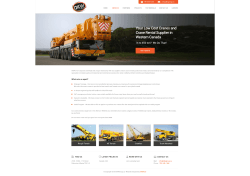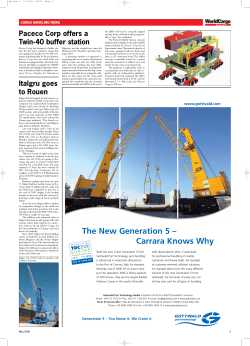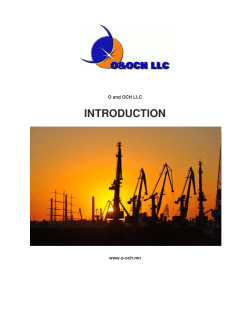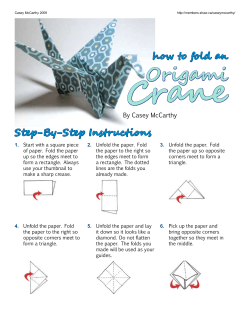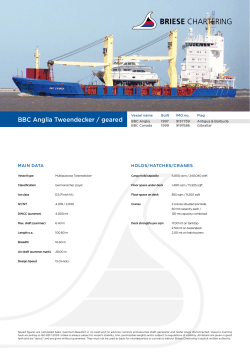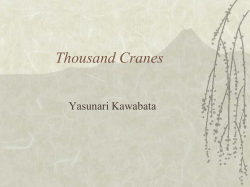
Download
RLB CRANE INDEXª Middle East 2nd Edition – May 2015 Rider Levett Bucknall’s 2015 Crane IndexTM, released during the month of May, shows an increase in crane counting Dubai and Doha, and a slight decrease in Abu Dhabi. This highlights a continuous economic growth and maturity of the construction market despite the drop in oil prices and the political uncertainty reigning in the region. UNITED ARAB EMIRATES DUBAI Key economic and financial indicators, including real estate prices, airport arrivals and hotel occupancy, point to further acceleration of the UAE’s economic growth. Positively, Dubai’s Real Estate demand was not considerably impacted by the oil prices due to the economic diversity of the emirate and its position as a regional business hub. The RLB Crane IndexTM expanded its coverage this quarter as many new cranes are being spotted in areas not visited previously. Such areas are Jebel Ali Industrial Zone, the Green Community and Silicon Oasis. As per the RLB Crane IndexTM, the Residential sector has the highest count 362 cranes accounted for. While many residential units were delivered during the first quarter, districts like Jebel Ali Industrial Zone Karama, Al Nahda, Al Barsha, International Media Production Zone and Sports City recorded a substantial increase in cranes compared to last year as developers are focusing on affordable mid to low-end residential developments which remain in high demand due to the limited supply. Dubai Marina and Downtown are still expanding with more residential projects being built while other developments like Jumeirah Lakes Towers (JLT) and Business Bay show a decrease in crane count as a big number of residential towers are in their final completion stages or already being delivered. May 2015 % Movement Dec 2014 % Residential 362 62% 22 340 72% Commercial 99 17% 57 42 9% Hotel 63 11% 12 51 11% Other 23 4% 6 17 4% Retail 15 3% 3 12 3% Education 7 1% 6 1 0% Recreation 7 1% 1 6 1% Health 6 1% 3 3 1% Civic 5 1% 2 3 1% Civil - - - - - TOTAL 587 - 112 475 - With positive recovery signs of the UAE’s market, Dubai’s position as the central hub for global corporations in the Middle East proved to remain strong and as a result is impacting the Commercial sector which significantly increased in the number of cranes during the first quarter of 2015. With 99 cranes on office developments, RLB Crane IndexTM highlights a solid demand in good quality offices especially across major free-zones which attract non-oil related sectors. Major new developments are noted in Meydan area, Hamriyah Port and Trade Centre area. Business Bay and JLT remain with the highest number of Commercial projects. Since the December 2014 count, RLB Crane IndexTM recorded an increase of 23% in the Hospitality sector bringing the total count to 63 cranes. This shows Dubai’s commitment to investing in touristic and leisure attractions and expanding its hotel infrastructure in preparation for the Expo 2020.TECOM, Business Bay and Al Barsha have the highest number of cranes on hotels and serviced apartments. With the continuous economic diversification and growth, the Industrial sector shows a considerable increase in cranes since last year’s count. Al Quoz Area recorded the highest number of cranes with over 20 warehouses and manufacturing facilities under construction in the area. As for the Retail market, although it is noted to be the leading sector in the region, it is still being developed with a continuous growth plan until the Expo 2020. Dubai is constantly attracting new retailers and brands as well as developing different retail marketing strategies which maintains a high level of market attraction and demand. The RLB Crane IndexTM records 15 cranes in April 2015 showing an increase by 3 cranes since December 2014. The Recreation sector is in constant development and expansion across different areas in Dubai as it is the basis of tourism and economic stimulation. With major projects in the pipeline, the RLB Crane IndexTM places the sector in fifth place with 7 cranes, a slight increase since the last count mainly due to a sports stadium development next to Al Ahli Riding Club. Also in fifth place is the Education sector, which has marked an increase of 5 cranes since last December’s count with 2 schools launched by Gems Education and new developments in Dubai Academic City. Dubai’s rapid growth drives the government on placing importance and high priority to implement a solid education system for human capital development and economic sustainability. The RLB Crane IndexTM recorded 6 cranes within the Healthcare sector, a notable increase to the count with Al Maktoum Hospital Redevelopment in progress. The healthcare sector will continue its growth with the recent launch of the second phase of Dubai Healthcare City project, in line with the UAE vision 2021promoting the UAE as a medical and research hub. As for the Civic sector, 5 cranes were accounted for within Dubai showing a steady development since last December. The RLB Crane IndexTM recorded an impressive amount of active cranes during the first quarter of 2015 totaling 587 cranes across Dubai, an increase by over 100 cranes since December 2014. Dubai Cranes Breakdown 350 300 250 200 150 100 50 Residential Commercial Hotel Other Retail Education Recreation Health Civic May-15 362 99 63 23 15 7 7 6 5 Dec-14 340 42 51 17 12 1 6 3 3 ABU DHABI Abu Dhabi maintains a steady and healthy overall economic growth in 2015. The Government is being more vigilant with their spending while shifting the construction industry’s focus towards social infrastructure promoting a mature and sustainable economy. The skyline is still dominated by cranes on Residential development as well as Industrial &Infrastructure projects which account for 45% and 33% of the total number respectively. As highlighted by the RLB Crane IndexTM, Abu Dhabi is investing heavily in its urban expansion and Industrial sector growth such as renewable energy and petrochemicals as well as the aviation and transport sectors. The Residential sector in Abu Dhabi remains stable with 109 cranes, a decrease by more than 20 cranes since last December’s count mainly due to the completion and handovers of some projects and a lag before the commencement of new projects. The main areas with residential developments are Reem and Yas Islands, Al Raha Beach and the Airport road. Government spending continues to shape the market with greater focus on Industrial and Infrastructure projects which show healthy signs of growth with 79 cranes counted across the city, a slight increase since last year mainly due to developments in the Mafraq area and Al Mussafah. The Commercial sector has the highest count with 21 cranes in the emirate’s skyline highlighting an increase by more than double since last December’s count. Major office developments are noted beside Abu Dhabi Mall, on Yas Island, Reem and Maryah Islands, the Airport road and along Rashid Ben Maktoum road in Sports City. With Abu Dhabi’s education plan being a top priority and an important part to achieving a successful economic 2030 vision, the government is committed to delivering new schools and educational facilities and continues to enhance their programs and apply best practices. The Education sector recorded 14 cranes in Abu Dhabi, a drop of 3 cranes since last December 2014with two schools nearing completion in Al Rawdah and Al Khalidiya districts. With regards to the Hospitality sector, the RLB Crane IndexTM recorded an increase in cranes making the total count for the first half of 2015 at 7 cranes. New cranes have been placed on the Rotana hotel on Saadiyat Island. The new supply in hotels has been steady in Abu Dhabi supporting a healthy recovery. May 2015 % Movement Dec 2014 % Residential 109 44% -28 137 55% Commercial 21 9% 12 9 4% Hotel 7 3% 2 5 2% Other 79 32% 9 70 28% Retail - - - - - Education 14 6% -3 17 7% Recreation 4 2% 4 - - Health 6 2% 2 4 2% Civic 7 3% -2 9 4% Civil - - - - - TOTAL 247 - -4 251 - The Civic sector also recorded 7 cranes, noting a drop of 2 cranes attributed to the construction progress on the Louvre Abu Dhabi. As for the Healthcare sector, the crane count slightly increased from 4 to 6 cranes with the aim to answer the growing population’s needs and ensure a solid healthcare system is in place matching the continuous economic growth and improvement. New cranes have been added to Yas Marina skyline with new recreation expansionin Yas Marina, developing it further as a destination for general public entertainment. Abu Dhabi’s overall outlook is positive and although the recovery pace is still slow, the construction industry continues to show healthy improvements with 247 cranes recorded by the RLB Crane Index TM Abu Dhabi Cranes Breakdown 140 120 100 80 60 40 20 Residential Other Commercial Education Hotel Civic Health Recreation May-15 109 79 21 14 7 7 6 4 Dec-14 137 70 9 17 5 9 4 Retail Civil STATE OF QATAR DOHA RLB Crane IndexTM Middle East has been introduced in Qatar covering the city of Doha and surrounding major centres (excluding Lusail City). The positive growth of crane numbers across Doha highlights a significant amount of construction work in progress across the city. The Doha skyline shows a significant number of new crane installations since the last count in December 2014. May 2015 % Movement Dec 2014 % Residential 59 17% 13 46 16% Commercial 66 19% 6 60 22% Hotel 31 9% 7 24 9% Other - - - - - Retail 36 10% 4 32 11% Education 7 2% -1 8 3% Construction activities and infrastructure developments such as the roads, railways and stadiums are key drivers for Doha’s economy and guarantee a robust future for the construction industry and the non-hydrocarbon sector. Recreation 23 7% 16 7 3% Health 10 3% -1 11 4% Civic 36 10% 7 29 10% Civil 85 24% 23 62 22% With all major projects generally being policy driven, the primary focus is strengthening the current infrastructure followed by overall economic diversification and cultural growth. According to the RLB Crane IndexTM, the Civil sector in Doha has the highest with 85 cranes, noting an increase of 23 cranes since last December count. The increase is mainly due to the work commencement on the various rail related projects for the Doha Metro programme. TOTAL 353 - 51 279 - Qatar’s commercial sector remains with the second highest count with a slight increase in crane count totaling 66 cranes in April 2015. The RLB Crane IndexTM recorded 59 Residential cranes indicating an increase since the last count and a significant level of investment in the sector. The Pearl Qatar development account for one third of the Residential cranes. Doha’s retail sector s showing positive growth signs with 36 cranes. This count is expected to increase further with the rising expatriate population and demand for retail brands. Major malls and retail shops under construction are noted including Msheireb Downtown, Doha Mall and Festival City. As Qatar is looking to enhance its tourism sector for a successful FIFA World Cup in 2022, the national vision goes further by building a more authentic type of tourism, with focus on historical sites and local cultural entertainment offerings. The Civic sector in Doha recorded 36 cranes. A major portion of the cranes are recorded on the National Museum and the Katara Village which remain the largest contributors since last December. RLB Crane IndexTM recorded 31 cranes in the Hospitality sector showing a 30% increase in the level of activity. While a number of new hotels are scheduled to open before the end of the year, the demand for hotel accommodation is expected to grow as the 2022 World Cup will be attracting a lot of tourists and football fans. The Sports and Recreation sector recorded a significant increase since last December with 23 cranes spotted, more than three times the last count value. The Khalifa Stadium in Aspire Zone and Al Bidda Park account for bulk of the additional count. The RLB Crane IndexTM for the recreational sector is expected to continuously evolve as the city of Doha gets ready for the World Cup and long term self-sustainability plans. Lastly, the RLB Crane IndexTM highlights a crane count of 10 cranes in the Health sector and 7 cranes in the Education sector. With a significant programme of health and education projects planned across Qatar, it is expected that the RLB Crane IndexTM for these sectors will show significant movement over the next few periods. Overall, the RLB Crane IndexTM May report shows a significant increase of cranes in Doha. The revised total of 353 indicates significant growth in activity. The recent fall in Global oil prices, along with an increased focus by Qatar’s government on reviewing project priorities, is expected to have an impact on the amount and timing of future projects. However, an overall positive growth trend is expected to continue as progress in non-hydrocarbon sectors, particularly infrastructure, retail, sport and social development, continues toward achieving Qatar’s National Vision 2030. Doha Cranes Breakdown 350 300 250 200 150 100 66 60 50 59 46 36 32 36 29 31 24 23 7 10 11 8 7 Commercial Residential Retail Civic Hotel Recreation Health Education May-15 66 59 36 36 31 23 10 7 Dec-14 60 46 32 29 24 7 11 8 Other For further comments, please contact: Sam Graham Director +974 3361 4958 sam.graham@ae.rlb.com Hanan Saliba Business Development Manager +971 5 6389 2887 hanan.saliba@ae.rlb.com rlb.com ABOUT THE RLB CRANE INDEX TM Rider Levett Bucknall’s RLB Crane Indexª published biannually, tracks the number of cranes in the significant centres of Abu Dhabi, Dubai and Doha. The count gives a simplified measure of the current state of the construction industry’s workload in each of these locations. Each RLB office physically counts all fixed cranes appearing on each city’s skyline twice yearly which provides the base information for the Index.
© Copyright 2025
